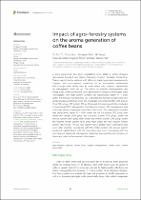| dc.contributor.author | Virginio Filho, Elias de Melo | |
| dc.contributor.author | y otros 5 autores más | |
| dc.date.accessioned | 2022-12-14T19:28:37Z | |
| dc.date.available | 2022-12-14T19:28:37Z | |
| dc.date.issued | 2022 | |
| dc.identifier.uri | https://repositorio.catie.ac.cr/handle/11554/12197 | |
| dc.description.abstract | A long experiment has been established since 2000 at CATIE (Tropical Agricultural Research and Higher Education Center), Turrialba, Costa Rica. Twenty agro-forestry systems with different shade types and managements (organic and non-organic) consisting of an incomplete randomized block-design with shade tree as main effect and subplots represented by management were set up. The effects of different managements and shade types on the aroma and color generation of roasted coffee beans were investigated. The total protein content was significantly higher (P < 0.05) under the intensive conventional (IC) (168 g/Kg) and intensive organic (IO) (167 g/Kg) managements than under the moderate conventional (MC) (153 g/Kg in IC vs. MC group, 157 g/Kg in MC vs. IO group). Comparing with the moderate conventional (MC) management, the intensive organic (IO) management had a stronger ability to generate more flavor and color. The total protein content was significantly higher (P < 0.05) under the full sun system (172 g/Kg) than under the shaded (159 g/Kg) and Erythrina system (155 g/Kg), under the service system (165 g/Kg) than under the timber system (146 g/Kg), under the legume timber system (170 g/Kg) than under the non-legume timber system (152 g/Kg). The full sun system had a greater flavor generation and color after roasting. Comparing with the timber system, the service system produced roasted beans with the more flavor and color. Comparing with the non-legume shade tree, the legume shade tree improved the performance of flavor and color in the roasted coffee beans | es_ES |
| dc.format.extent | 13 páginas | es_ES |
| dc.language.iso | en | es_ES |
| dc.publisher | Frontiers | es_ES |
| dc.relation.ispartof | Frontiers in Nutrition | es_ES |
| dc.relation.uri | https://doi.org/10.3389/fnut.2022.968783 | es_ES |
| dc.subject | AGROFORESTERIA | es_ES |
| dc.subject | AGROFORESTRY | es_ES |
| dc.subject | SISTEMAS AGROFORESTALES | es_ES |
| dc.subject | AGROFORESTRY SYSTEMS | es_ES |
| dc.subject | ARBOLES DE SOMBRA | es_ES |
| dc.subject | SHADE TREES | es_ES |
| dc.subject | ORGANIC MANAGEMENT | es_ES |
| dc.subject | COFFEE COLOR | es_ES |
| dc.subject | AROMA GENERATION | es_ES |
| dc.subject.other | Sede Central | es_ES |
| dc.title | Impact of agro-forestry systems on the aroma generation of coffee beans | es_ES |
| dc.type | Artículo | es_ES |
| dc.creator.id | https://orcid.org/0000-0003-2063-0010 | es_ES |
| dc.identifier.status | openAccess | es_ES |


